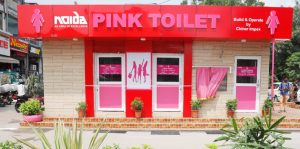THE PINK TOILETS OF INDIA
A reflection on the idea of Public Toilets in Indian Cities.
The move to make toilets in Indian cities was a great initiative. As an architect, the author would like to reflect upon the implementation of this noble idea, into the urban fabric of India.

1. Why PINK?
Why are we obsessed with the colour? Was the intention to make the toilets stand out as an eye catching facility? Toilets are a basic necessity in every house, every city. Hence, what is the relevance of this flashy materials and strong colours. Is it just meant to say “We Have Safe Toilets”?
Do we need a colour, to make the facility women friendly? We are in a world where women are in every leading positions. What they deserve is not preference or consideration but equal presence and freedom of expression. Hence, do we need to segregate them with a colour, or should we integrate them into a society where they can enjoy an equal status and facilities.
2. Are they ideally Placed or Located?
The process of building public toilets into the existing urban fabric needs a thorough research as to where is the need for them. With a broad formula of placing urban toilets at every 1 or 2 km, these toilets stand deserted with no purpose or meaning at many junctions. While a detailed study of the local area would have helped in building these toilets at specifically identified pockets.
3. Are they meant to bring Aesthetic Value additions to the Public Plazas?
By placing these highly celebrated toilets into the centre of urban plazas are we enhancing the space or deteriorating the beauty of conventional city centres? Having a look at the Noida, sector 50 market it is clearly evident that there are no value additions in terms quality of the plaza. The plaza has always been a busy one with food vendors and parking spaces.
The toilet which is placed right at the entry to the market, has become the face of the plaza/market, welcoming each and every person entering the market. This toilet building with its bright pink colour has become the “Gateways of urban plazas”. Can this be integrated in a sophisticated manner to make them look more elegant, subtle and not just some highly ornamented toilets.

4. Standard Design Crisis
The doors of the public toilets at Noida sector 50 market, opens right on to the road making them an eye sore, and hurting the privacy of every one using the facility. While this front of the building, facing the road, had immense advertising and branding potentials the idea have never been explored.
The standard design palette that need to be copied has not left much opportunity to creatively decide on the pros and cons of placing the building. Making a theme or a guideline rather than a standard design would have improved the overall integration of these buildings in a better manner into the city fabric.
5. Maintenance and Financial Viability
With a public facility always there is a question as to who will manage and maintain the facility especially with a vision for the longer run. Can these toilets be clubbed with convenient stores and 24x 7 shops that can run their business while maintaining a public facility? Or can these toilets be clubbed with other necessary social service centres and small retail spaces to generate a better income?
6. Converting the urban public toilets into “Not Just Toilets”
These toilets have to be designed in a comprehensive manner. They can be turned into utility service cores of the cities, which have an identity of not just toilets but be ambassadors of an administration who cares about its people and cities. The public toilets can be integrated with power generation, awareness campaigns, ticket booths, rest areas, bus shelters, convenience stores and many other facilities that are needed for a progressive society. Hence every toilet needs to be carefully designed to suit their requirement while following a unique identity guideline which is not based on colours or its external appearance but utility and sustainability.

